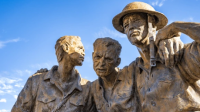Introduction: The Establishment of a New World Colony
Founding of Quebec City (1608) : The Birth of French Canada – In 1608, the French explorer Samuel de Champlain founded Quebec City, laying the cornerstone for what would become the heart of French Canada. Located on the banks of the St. Lawrence River, Quebec City became the center of New France, a vast territory that stretched from the Atlantic coast to the Great Lakes and down the Mississippi River. Champlain’s establishment of Quebec City marked the beginning of a significant European presence in North America and set the stage for centuries of cultural, political, and economic developments that shaped the region’s history.
The founding of Quebec City was not just a colonial endeavor; it was also a strategic move in France’s broader efforts to establish a foothold in the New World. The city’s location was chosen for its strategic advantages, including its defensible position, access to rich natural resources, and its potential as a hub for trade with Indigenous peoples. This article explores the context, challenges, and significance of Quebec City’s founding, offering insights into how this early French settlement became a pivotal point in North American history.
The Context of European Exploration and Colonization
The early 17th century was a period of intense exploration and colonization for European powers, driven by the desire to expand their empires, access new resources, and establish trade routes. France, like its European rivals, was eager to stake its claim in the New World, and the founding of Quebec City was a key part of this broader strategy.
France’s Ambitions in the New World
By the early 1600s, France had already established a presence in the New World through earlier explorations and the establishment of temporary settlements. However, these efforts had been largely unsuccessful in creating a permanent foothold in North America. The French crown recognized the need for a more strategic and sustained approach to colonization, one that would secure France’s influence in the region and provide economic benefits through the fur trade and other ventures.
France’s ambitions in the New World were motivated by a combination of economic, religious, and geopolitical factors. The lucrative fur trade, which involved the exchange of European goods for beaver pelts and other animal furs, was a major driving force behind French exploration and settlement. Additionally, the French sought to spread Catholicism among the Indigenous populations and to counter the growing influence of Protestant powers such as England and the Netherlands.
The decision to establish a permanent settlement at Quebec was part of a broader strategy to secure France’s claims in the New World and to establish a base from which further exploration and expansion could be carried out. Quebec City was seen as the key to controlling the St. Lawrence River, a vital trade route that connected the interior of North America to the Atlantic Ocean.
Samuel de Champlain: The Father of New France
Samuel de Champlain, often referred to as the “Father of New France,” played a central role in the establishment of Quebec City. A skilled navigator, cartographer, and diplomat, Champlain had already made several voyages to North America by the time he founded Quebec. His experience and knowledge of the region made him the ideal candidate to lead France’s efforts to establish a permanent settlement.
Champlain’s vision for Quebec was not just as a trading post, but as a thriving colony that would serve as the foundation for French expansion in North America. He believed that a successful colony required not only economic activity but also strong relationships with Indigenous peoples, who were essential partners in the fur trade and other enterprises.
Champlain’s leadership and determination were crucial in overcoming the many challenges that faced the fledgling colony. His efforts to build alliances with Indigenous nations, establish a sustainable settlement, and explore the surrounding region laid the groundwork for the growth of New France.
The Strategic Importance of Quebec’s Location
The location of Quebec City on the St. Lawrence River was carefully chosen for its strategic advantages. The site offered a natural defensive position, with steep cliffs on one side and the river on the other, making it difficult for potential enemies to attack. The location also provided easy access to the interior of North America, allowing the French to control the fur trade and to explore and expand their territory.
The St. Lawrence River was a vital artery for trade and communication, connecting the interior of the continent to the Atlantic Ocean. By controlling Quebec, the French could regulate the flow of goods and people along this important waterway, ensuring their dominance in the region. The city’s location also allowed the French to maintain close ties with their Indigenous allies, who played a crucial role in the success of the colony.
The strategic importance of Quebec’s location would become even more apparent in the years to come, as the city played a central role in the defense of New France against British and Indigenous forces. Quebec’s position on the St. Lawrence River made it a key target in the struggle for control of North America, and its fate would have far-reaching consequences for the future of the continent.
The Founding of Quebec City: Challenges and Achievements
The founding of Quebec City was a monumental undertaking that required overcoming numerous challenges, from the harsh climate and difficult terrain to the need for cooperation with Indigenous peoples. Despite these obstacles, Champlain and his small group of settlers succeeded in establishing a permanent foothold in the New World.
Building the Settlement: Overcoming the Elements
The construction of Quebec City began in the summer of 1608, with Champlain and his men clearing land, building fortifications, and erecting the first structures of what would become a thriving settlement. The early buildings included a storehouse, a residence for Champlain, and a small fort to protect the settlers from potential attacks.
The harsh climate of the region posed a significant challenge to the early settlers. The cold winters, heavy snowfall, and short growing season made it difficult to grow crops and maintain a stable food supply. The settlers relied on supplies from France, as well as trade with Indigenous peoples, to survive the early years of the colony.
Despite these challenges, Champlain’s leadership and the determination of the settlers allowed them to persevere. The early fortifications and structures provided a foundation for the growth of the settlement, and over time, Quebec City would expand to become the center of French power in North America.
Relations with Indigenous Peoples: Diplomacy and Alliance Building
One of Champlain’s key strategies for ensuring the success of the colony was to build strong alliances with the Indigenous peoples of the region. He recognized that the survival of the settlement depended on cooperation with Indigenous nations, who controlled the fur trade and had a deep knowledge of the land.
Champlain established close relationships with several Indigenous groups, including the Algonquin, Montagnais, and Huron-Wendat. These alliances were based on mutual respect and the recognition of shared interests, particularly in the fur trade. Champlain’s diplomacy and efforts to understand and respect Indigenous customs and traditions played a crucial role in securing the support of these groups.
The alliances that Champlain forged with Indigenous peoples were not without challenges, however. The French were drawn into the complex web of Indigenous rivalries and conflicts, particularly the ongoing struggle between the Huron-Wendat and the Iroquois Confederacy. Champlain’s decision to support his Indigenous allies in their conflicts with the Iroquois would have lasting consequences for the colony and for French relations with Indigenous nations.
The Fur Trade: The Economic Lifeline of the Colony
The fur trade was the economic engine that drove the growth of Quebec City and the broader colony of New France. The exchange of European goods for beaver pelts and other animal furs provided the colony with the resources it needed to survive and thrive.
Champlain’s alliances with Indigenous peoples were crucial to the success of the fur trade. Indigenous hunters and trappers provided the furs that were in high demand in Europe, while the French offered metal tools, weapons, and other goods in exchange. The fur trade created a complex network of relationships and exchanges that connected the colony to the broader Atlantic world.
The economic success of the fur trade allowed Quebec City to grow and attract more settlers, traders, and missionaries. The city became a hub for trade and commerce, and its strategic location on the St. Lawrence River allowed it to control the flow of goods into and out of the interior of the continent. The wealth generated by the fur trade helped to sustain the colony and laid the foundation for its future expansion.
The Growth of New France: Quebec City as a Colonial Capital
As Quebec City grew and developed, it became the capital of New France and the center of French colonial power in North America. The city’s growth was fueled by the expansion of the fur trade, the arrival of new settlers, and the development of agriculture and other industries.
Expansion and Settlement: Building a French Presence in North America
The early years of Quebec City were marked by slow but steady growth. The arrival of new settlers from France, including farmers, artisans, and soldiers, helped to expand the colony and establish a more stable and self-sufficient community. The French crown encouraged settlement by offering land grants and other incentives to those willing to make the journey to the New World.
The expansion of Quebec City and the surrounding region was also driven by the need to secure French control over the territory. The establishment of new settlements and forts along the St. Lawrence River and further into the interior helped to solidify French claims to the land and to protect the colony from potential threats, both from Indigenous nations and rival European powers.
The growth of Quebec City and New France was not without challenges, however. The harsh climate, difficult terrain, and ongoing conflicts with Indigenous nations and European rivals made the expansion of the colony a slow and often perilous process. Despite these obstacles, Quebec City continued to grow and develop, becoming a symbol of French power and influence in North America.
The Role of the Catholic Church: Missionaries and Education
The Catholic Church played a central role in the development of Quebec City and New France. The French crown, in partnership with the Church, saw the colony as not only an economic venture but also a mission to spread Catholicism among the Indigenous peoples of North America.
Missionaries, including members of the Jesuit and Recollet orders, were among the early settlers in Quebec City. They established missions and schools, where they sought to convert Indigenous peoples to Christianity and to educate both Indigenous and French children. The Church also played a key role in providing social services, including health care and support for the poor and needy.
The influence of the Catholic Church extended beyond religion and education. The Church was a major landowner in New France, and its leaders often played a prominent role in the colony’s governance and decision-making. The Church’s presence in Quebec City and New France helped to shape the cultural and social fabric of the colony, reinforcing French traditions and values in the New World.
Defense and Conflict: Protecting the Colony
The strategic importance of Quebec City made it a key target in the ongoing struggle for control of North America. The French had to defend the colony against both Indigenous nations and rival European powers, particularly the British, who sought to expand their influence in the region.
The fortifications of Quebec City were gradually strengthened over the years, with the construction of walls, bastions, and other defensive structures. The city’s position on the cliffs overlooking the St. Lawrence River made it a formidable fortress, but it was also vulnerable to siege and attack.
One of the most significant conflicts involving Quebec City was the French and Indian War (1754-1763), which pitted the French and their Indigenous allies against the British and their Indigenous allies. The war culminated in the Battle of the Plains of Abraham in 1759, where British forces under General James Wolfe defeated the French forces defending Quebec City. The fall of Quebec marked the beginning of the end for French rule in North America, and the city was ceded to the British in the Treaty of Paris in 1763.
The Legacy of Quebec City: A Lasting French Presence in Canada
Despite the loss of Quebec City to the British, the city’s founding and early development left a lasting legacy in Canada. Quebec City remains a vibrant center of French culture, language, and history, and its legacy continues to shape the identity of Quebec and Canada as a whole.
French Language and Culture: A Resilient Heritage
The founding of Quebec City established French as the dominant language and culture in the region, a legacy that endures to this day. The city became the cultural and intellectual heart of New France, and even after the British conquest, the French language and culture remained strong.
Quebec City and the province of Quebec are unique in North America for their preservation of French language, culture, and traditions. The city is home to numerous cultural institutions, including museums, theaters, and universities, that celebrate and promote French heritage. The city’s historic architecture, including the famous Château Frontenac and the old city walls, reflects its rich history and French roots.
The resilience of French culture in Quebec City and the broader province of Quebec is a testament to the enduring legacy of the city’s founding. The preservation of French language and culture in Quebec is a source of pride for its residents and a key part of the province’s identity within Canada.
The Historical Significance of Quebec City
Quebec City is one of the oldest European settlements in North America, and its historical significance is recognized both in Canada and internationally. The city’s founding and early development played a crucial role in the history of Canada, shaping the cultural, political, and social landscape of the country.
Quebec City’s historic district, known as Old Quebec, is a UNESCO World Heritage site, recognized for its well-preserved architecture and its importance as a symbol of French colonial history in the New World. The city’s historic sites, including the Citadelle of Quebec, the Plains of Abraham, and the Notre-Dame de Québec Basilica-Cathedral, attract visitors from around the world and serve as reminders of the city’s rich and complex history.
The legacy of Quebec City’s founding continues to influence Canadian politics and society. The city is a focal point for discussions about the relationship between Quebec and the rest of Canada, particularly in terms of language rights, cultural preservation, and political autonomy. Quebec City’s history and identity are central to the ongoing debates about Canada’s national identity and its diverse cultural heritage.
Conclusion: Reflecting on the Founding of Quebec City
The founding of Quebec City in 1608 by Samuel de Champlain was a pivotal moment in the history of North America. The establishment of this French settlement on the banks of the St. Lawrence River marked the beginning of a new chapter in the European colonization of the continent and laid the foundation for the development of French Canada.
Quebec City’s strategic location, economic importance, and cultural significance made it the heart of New France and a key player in the struggle for control of North America. Despite the challenges of harsh winters, conflicts with Indigenous nations, and rivalry with other European powers, Quebec City thrived and became a symbol of French resilience and determination.
Today, Quebec City stands as a testament to the enduring legacy of its founding. The city’s rich history, vibrant culture, and unique identity continue to shape the province of Quebec and Canada as a whole. Reflecting on the founding of Quebec City offers valuable insights into the complexities of colonial history and the lasting impact of early European settlements in the New World.
FAQ About the Founding of Quebec City
Who founded Quebec City and when?
Quebec City was founded by French explorer Samuel de Champlain in 1608. It became the center of New France and played a crucial role in the development of French Canada.
Why was Quebec City founded?
Quebec City was founded as part of France’s broader strategy to establish a permanent presence in North America. The city’s location on the St. Lawrence River was chosen for its strategic advantages, including its defensible position and access to the fur trade.
What challenges did the early settlers of Quebec City face?
The early settlers of Quebec City faced numerous challenges, including harsh winters, food shortages, and conflicts with Indigenous nations. The colony also had to contend with rivalry from other European powers, particularly the British.
What was the significance of Quebec City in New France?
Quebec City was the capital of New France and the center of French colonial power in North America. It played a key role in the fur trade, served as a hub for exploration and expansion, and was a focal point for French culture and religion.
How is the legacy of Quebec City’s founding remembered today?
The legacy of Quebec City’s founding is remembered through its preservation as a UNESCO World Heritage site, its role as a center of French culture in Canada, and its significance in Canadian history. The city remains a vibrant and culturally rich community that continues to celebrate its French heritage.







Thanks for posting. I really enjoyed reading it, especially because it addressed my problem. http://www.hairstylesvip.com It helped me a lot and I hope it will help others too.